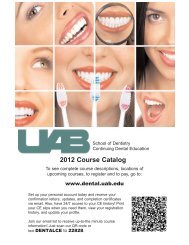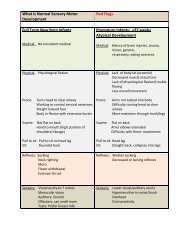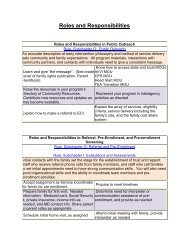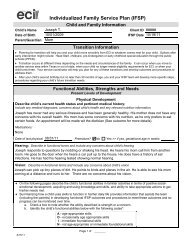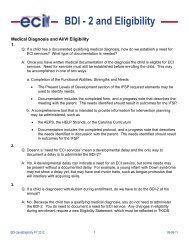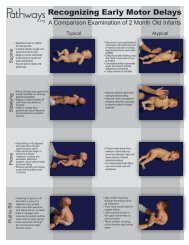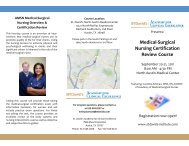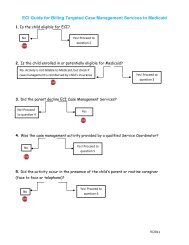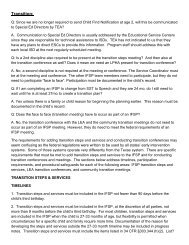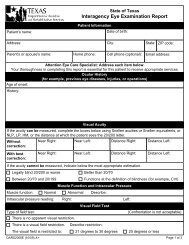Oral Motor and Feeding in Very Young Infants Content ... - ABC Signup
Oral Motor and Feeding in Very Young Infants Content ... - ABC Signup
Oral Motor and Feeding in Very Young Infants Content ... - ABC Signup
- No tags were found...
Create successful ePaper yourself
Turn your PDF publications into a flip-book with our unique Google optimized e-Paper software.
12/4/2012<br />
<strong>Oral</strong> <strong>Motor</strong> <strong>and</strong> <strong>Feed<strong>in</strong>g</strong> <strong>in</strong> <strong>Very</strong><br />
<strong>Young</strong> <strong>Infants</strong><br />
A web<strong>in</strong>ar for ECI teams<br />
<strong>Content</strong> of Tra<strong>in</strong><strong>in</strong>g<br />
• Incidence <strong>and</strong> red flags<br />
• Inter-relatedness of feed<strong>in</strong>g <strong>and</strong> other<br />
developmental doma<strong>in</strong>s<br />
• Application of ECI eligibility requirements<br />
relevant to feed<strong>in</strong>g<br />
• Needs assessment <strong>and</strong> plann<strong>in</strong>g<br />
• Develop<strong>in</strong>g the IFSP <strong>and</strong> outcomes<br />
1
12/4/2012<br />
Incidence & Prevalence<br />
25-45% of typically<br />
develop<strong>in</strong>g children<br />
33-80% of children with<br />
developmental<br />
disabilities<br />
35% of <strong>in</strong>fants exhibit<br />
food selectivity <strong>and</strong><br />
refusal<br />
57-92% of children with<br />
CP have dysphagia<br />
(feed<strong>in</strong>g disorders)<br />
31% of NICU graduates<br />
will experience feed<strong>in</strong>g<br />
difficulties before one<br />
year of age<br />
(Hawdon, et al, 2002)<br />
Occurrence is highest <strong>in</strong><br />
children with physical<br />
disabilities, medical<br />
illness <strong>and</strong> prematurity.<br />
Incidence <strong>and</strong> Prevalence<br />
• <strong>Feed<strong>in</strong>g</strong> difficulties can<br />
cont<strong>in</strong>ue as the <strong>in</strong>fant gets<br />
older<br />
• <strong>Feed<strong>in</strong>g</strong> difficulties may be<br />
identified later, as volume<br />
of fluid <strong>in</strong>take <strong>in</strong>creases<br />
Although parents voice concern<br />
about feed<strong>in</strong>g on average<br />
around 7.4 months of age, they<br />
are not referred to EI until 15.7<br />
months of age<br />
- Bailey Jr., et. Al. (2004)<br />
2
12/4/2012<br />
Don’t Wait!<br />
• <strong>Feed<strong>in</strong>g</strong> is a developmental<br />
process<br />
• Early experiences are key to longterm<br />
success<br />
• When feed<strong>in</strong>g development is<br />
<strong>in</strong>terrupted, children may<br />
demonstrate<br />
– <strong>Oral</strong> sensorimotor dsyfunction<br />
– Undernutrition (FTT)<br />
– Poor growth<br />
– Delayed development<br />
– Poor academic achievement<br />
– Psychological problems<br />
– Loss of overall health <strong>and</strong> wellbe<strong>in</strong>g<br />
From Jenny McGlothl<strong>in</strong> <strong>in</strong> web<strong>in</strong>ar<br />
Assessment & Intervention of <strong>Feed<strong>in</strong>g</strong> <strong>in</strong><br />
the <strong>Young</strong> Infant<br />
5<br />
Red Flags for <strong>Feed<strong>in</strong>g</strong>/<strong>Oral</strong> <strong>Motor</strong><br />
• <strong>Oral</strong>-motor dysfunction<br />
• Medical Hx of Dx related to<br />
feed<strong>in</strong>g disruption<br />
– EX: Bronchopulmonary Dysplasia,<br />
cardiac, neuro impairment, GERD<br />
• Supplemental tube feed<strong>in</strong>gs<br />
• Failure to match diet/quantity to<br />
developmental age<br />
• Poor meal schedul<strong>in</strong>g or other<br />
parental feed<strong>in</strong>g strategies<br />
From Jenny McGlothl<strong>in</strong> <strong>in</strong> web<strong>in</strong>ar<br />
Assessment & Intervention of <strong>Feed<strong>in</strong>g</strong> <strong>in</strong><br />
the <strong>Young</strong> Infant<br />
6<br />
3
12/4/2012<br />
Red Flags for <strong>Feed<strong>in</strong>g</strong>/<strong>Oral</strong> <strong>Motor</strong><br />
• Excessive gagg<strong>in</strong>g or recurrent<br />
cough w/feed<strong>in</strong>g<br />
• Severe irritability or behavior<br />
problems dur<strong>in</strong>g feeds<br />
• History of recurrent pneumonia<br />
<strong>and</strong> fee<strong>in</strong>g difficulties<br />
• Lethargy or decreased arousal<br />
dur<strong>in</strong>g feed<strong>in</strong>g<br />
• Unexpla<strong>in</strong>ed food refusal <strong>and</strong><br />
under nutrition<br />
Recommendation for ECI Teams<br />
Ensure that a SLP or an OT (or other staff qualified to assess<br />
feed<strong>in</strong>g) evaluates every <strong>in</strong>fant who is under 6 months of age.<br />
Any time there are questions regard<strong>in</strong>g feed<strong>in</strong>g or oral motor,<br />
be sure to consult with the SLPs or OTs <strong>in</strong> your program.<br />
4
12/4/2012<br />
Important to Remember<br />
• Development <strong>in</strong> an<br />
<strong>in</strong>fant can’t be<br />
compartmentalized<br />
• In an <strong>in</strong>fant, feed<strong>in</strong>g is<br />
related to <strong>and</strong><br />
dependent on the<br />
other developmental<br />
areas<br />
Effect of Overall Tone & Gross<br />
<strong>Motor</strong> Development on <strong>Feed<strong>in</strong>g</strong><br />
Mobility develops from a<br />
proximal base of stability<br />
(middle of the body) toward<br />
more distal (farther away<br />
from the core of the body)<br />
control<br />
– Ref<strong>in</strong>ed development of oral<br />
motor skills is affected if<br />
proximal stability is an issue<br />
– <strong>Oral</strong> stability is dependent upon<br />
development of neck <strong>and</strong><br />
shoulder girdle stability, which<br />
are dependent upon trunk <strong>and</strong><br />
pelvic stability<br />
From Jenny McGlothl<strong>in</strong> <strong>in</strong> web<strong>in</strong>ar<br />
Assessment & Intervention of <strong>Feed<strong>in</strong>g</strong> <strong>in</strong><br />
the <strong>Young</strong> Infant<br />
10<br />
5
12/4/2012<br />
Effect of Overall Tone & Gross<br />
<strong>Motor</strong> Development on <strong>Feed<strong>in</strong>g</strong><br />
Hypotonia<br />
– Poor postural stability =<br />
decreased control of trunk,<br />
shoulders, head & neck<br />
– Dur<strong>in</strong>g feed<strong>in</strong>g, the baby<br />
may try to compensate by<br />
“fix<strong>in</strong>g” <strong>in</strong> a position or<br />
hyperextend<strong>in</strong>g (e.g.,<br />
pull<strong>in</strong>g back shoulders &<br />
extend<strong>in</strong>g jaw)<br />
– Tires easily <strong>and</strong> may cease<br />
feed<strong>in</strong>g before full<br />
From Jenny McGlothl<strong>in</strong> <strong>in</strong> web<strong>in</strong>ar<br />
Assessment & Intervention of <strong>Feed<strong>in</strong>g</strong> <strong>in</strong><br />
the <strong>Young</strong> Infant<br />
11<br />
Body Flat <strong>in</strong> Sup<strong>in</strong>e - Hypotonia<br />
6
12/4/2012<br />
Effect of Overall Tone & Gross<br />
<strong>Motor</strong> Development on <strong>Feed<strong>in</strong>g</strong><br />
Hypertonia<br />
– All movements are aga<strong>in</strong>st <strong>in</strong>creased<br />
tension/resistance of muscles<br />
– Tends to fix sp<strong>in</strong>e & limit movements to small<br />
range<br />
– Tire easily due to <strong>in</strong>creased work<br />
From Jenny McGlothl<strong>in</strong> <strong>in</strong> web<strong>in</strong>ar<br />
Assessment & Intervention of <strong>Feed<strong>in</strong>g</strong> <strong>in</strong><br />
the <strong>Young</strong> Infant 13<br />
Social Emotional<br />
Importance of <strong>Feed<strong>in</strong>g</strong><br />
<strong>Feed<strong>in</strong>g</strong> is the most<br />
basic type of<br />
nurtur<strong>in</strong>g.<br />
7
12/4/2012<br />
Evaluation <strong>and</strong> Assessment<br />
• BDI 2 may identify children who qualify<br />
due to feed<strong>in</strong>g difficulties.<br />
• 1 st three items <strong>in</strong> Self-Care:<br />
–SC4 Smooth Coord<strong>in</strong>ated Suck<br />
–SC5 Both h<strong>and</strong>s on bottle or breast<br />
–SC7 Mouths soft foods<br />
Cont<strong>in</strong>ue with Needs Assessment<br />
by ask<strong>in</strong>g 3 questions:<br />
1. Are the parents<br />
concerned about the<br />
child’s eat<strong>in</strong>g<br />
2. Does the child have a<br />
medical diagnosis or<br />
any structural<br />
limitations associated<br />
with difficulties <strong>in</strong> the<br />
area of feed<strong>in</strong>g<br />
3. Are there any oral<br />
motor <strong>in</strong>dicators of<br />
concern<br />
8
12/4/2012<br />
Cont<strong>in</strong>ue with Needs Assessment<br />
1. Are the parents<br />
concerned about the<br />
child’s eat<strong>in</strong>g<br />
• Gather <strong>and</strong> document<br />
detailed <strong>in</strong>formation<br />
about the concerns.<br />
• History <strong>and</strong> parent<br />
<strong>in</strong>terview<br />
• Observation<br />
• Cultural differences<br />
9
12/4/2012<br />
Response to <strong>Feed<strong>in</strong>g</strong><br />
If possible, allow caregiver to<br />
feed, <strong>and</strong> then take a turn<br />
feed<strong>in</strong>g so you can observe<br />
directly.<br />
• State control<br />
– Is baby able to ma<strong>in</strong>ta<strong>in</strong> calm<br />
state throughout feed<strong>in</strong>g<br />
Does baby start out or<br />
become disorganized<br />
• Behavioral Response<br />
– Do you notice any stress<br />
signals Does baby appear to<br />
be satisfied after feed<strong>in</strong>g (goes<br />
to sleep or appears<br />
calm/happy)<br />
From Jenny McGlothl<strong>in</strong> <strong>in</strong> web<strong>in</strong>ar<br />
Assessment & Intervention of <strong>Feed<strong>in</strong>g</strong><br />
<strong>in</strong> the <strong>Young</strong> Inf<br />
Assess<strong>in</strong>g Infant Cues<br />
Stress Signs: Moderate<br />
• Sigh<strong>in</strong>g<br />
• Sweat<strong>in</strong>g<br />
• Trembl<strong>in</strong>g (jaw/limb)<br />
• Facial grimac<strong>in</strong>g<br />
• Stra<strong>in</strong><strong>in</strong>g<br />
• Bowel movements<br />
• Multiple swallows<br />
• Sneez<strong>in</strong>g<br />
• Startl<strong>in</strong>g<br />
• Hiccups<br />
• Gasp<strong>in</strong>g<br />
• Fall<strong>in</strong>g asleep<br />
• Avert<strong>in</strong>g gaze<br />
• Increas<strong>in</strong>g hyper/hypotonicity<br />
• Yawn<strong>in</strong>g<br />
• Squirm<strong>in</strong>g or <strong>in</strong>creased activity level<br />
Stress Signs: Major<br />
• Cough<strong>in</strong>g<br />
• Spitt<strong>in</strong>g up<br />
• Arch<strong>in</strong>g/postur<strong>in</strong>g of trunk or extremities<br />
• Changes <strong>in</strong> vital signs<br />
• Changes <strong>in</strong> color<br />
• Respiratory pauses or breath hold<strong>in</strong>g<br />
• Chok<strong>in</strong>g<br />
• Gagg<strong>in</strong>g<br />
• Irregular respiration<br />
• Bradycardia<br />
From Jenny McGlothl<strong>in</strong> <strong>in</strong> web<strong>in</strong>ar<br />
Assessment & Intervention of <strong>Feed<strong>in</strong>g</strong><br />
<strong>in</strong> the <strong>Young</strong> Inf<br />
10
12/4/2012<br />
Cultural Differences<br />
Cultural differences <strong>and</strong><br />
expectations must be<br />
considered <strong>in</strong> all<br />
developmental areas when<br />
evaluat<strong>in</strong>g young children.<br />
The next two slides are<br />
summaries of studies about<br />
cultural differences<br />
regard<strong>in</strong>g feed<strong>in</strong>g. The full<br />
citations are provided <strong>in</strong><br />
the reference list.<br />
Cultural Differences<br />
“Health professionals are faced with a<br />
grow<strong>in</strong>g challenge to appreciate the<br />
cultural beliefs <strong>in</strong>fluenc<strong>in</strong>g <strong>in</strong>fant feed<strong>in</strong>g<br />
practices for both recent immigrants as<br />
well as for resident US ethnic groups.<br />
Discussions regard<strong>in</strong>g <strong>in</strong>fant feed<strong>in</strong>g often<br />
are the <strong>in</strong>itial <strong>in</strong>teraction between<br />
cl<strong>in</strong>ician <strong>and</strong> mother <strong>and</strong>, as such, are<br />
important <strong>in</strong> build<strong>in</strong>g a foundation of trust<br />
<strong>and</strong> rapport necessary for successful well<br />
child visits lead<strong>in</strong>g to optimal<br />
development of the <strong>in</strong>fant through<br />
childhood.” (Pak-Gorste<strong>in</strong>, S., et al., 2009)<br />
From Jenny McGlothl<strong>in</strong> <strong>in</strong> web<strong>in</strong>ar<br />
Assessment & Intervention of <strong>Feed<strong>in</strong>g</strong><br />
<strong>in</strong> the <strong>Young</strong> Inf<br />
11
12/4/2012<br />
Cultural Differences<br />
Authors <strong>in</strong>vestigated whether Asian-Indian (AI) mothers who immigrate to<br />
the US change their <strong>in</strong>fant feed<strong>in</strong>g beliefs from those held <strong>in</strong> India, <strong>and</strong> how<br />
the <strong>in</strong>fant feed<strong>in</strong>g beliefs of Anglo-American (AA) mothers differ from those<br />
held by Asian-Indian-American (AIA) mothers. Survey responses from 141<br />
AA mothers <strong>and</strong> 133 AIA mothers liv<strong>in</strong>g <strong>in</strong> the southeastern US, <strong>and</strong> 101 AI<br />
mothers liv<strong>in</strong>g <strong>in</strong> Coimbatore, India, were presented. The mean ages of the<br />
ethnic groups were similar, all 3 groups were relatively well educated, <strong>and</strong><br />
the AIA mothers had lived <strong>in</strong> the US for a median of 5.9 years. The <strong>in</strong>fant<br />
feed<strong>in</strong>g beliefs of the Asian-Indian-American (AIA) <strong>and</strong> Asian-Indian (AI)<br />
mothers <strong>in</strong>dicate that they are especially <strong>in</strong> need of services provided by<br />
dietitians <strong>and</strong> other health care providers. Otherwise, differences <strong>in</strong> beliefs<br />
were found between the 3 groups, except that all 3 groups believe that a<br />
baby should not take a bottle to bed. (Kannan S, et al.,1999)<br />
From Jenny McGlothl<strong>in</strong> <strong>in</strong> web<strong>in</strong>ar<br />
Assessment & Intervention of <strong>Feed<strong>in</strong>g</strong><br />
<strong>in</strong> the <strong>Young</strong> Infant<br />
Cont<strong>in</strong>ue with Needs Assessment<br />
2. Does the child have a<br />
medical diagnosis or any<br />
structural limitations<br />
associated with difficulties<br />
<strong>in</strong> the area of feed<strong>in</strong>g or<br />
oral motor<br />
• Review the first 7 slides of the<br />
archived web<strong>in</strong>ar Cl<strong>in</strong>ical<br />
Skills for Assessment <strong>and</strong><br />
Intervention of <strong>Feed<strong>in</strong>g</strong> <strong>in</strong> the<br />
<strong>Young</strong> Infant, Part 1.<br />
12
12/4/2012<br />
Factors that Limit <strong>Feed<strong>in</strong>g</strong> Skill<br />
Development<br />
Structural limitations<br />
• <strong>Oral</strong>-Facial (Choanal Atresia, Cleft<br />
Lip/Palate, Micrognathia,<br />
Macroglossia, Dental Malocclusions,<br />
Short L<strong>in</strong>gual Frenulum)<br />
• Gastro<strong>in</strong>test<strong>in</strong>al (Esophogeal<br />
Stricture, Pyloric Stenosis, Esophogeal<br />
Atresia, Anal Atresia,<br />
Tracheoesophageal Fistula, Congenital<br />
Diaphragmatic Hernia, Hiatal Hernia,<br />
Short Bowel Syndrome)<br />
• Respiratory <strong>and</strong> Cardiac<br />
(Tracheomalacia, Laryngomalacia,<br />
Pulmonary Atresia/Stenosis, Aortic<br />
stenosis, etc.)<br />
From Jenny McGlothl<strong>in</strong> <strong>in</strong> web<strong>in</strong>ar<br />
Assessment & Intervention of <strong>Feed<strong>in</strong>g</strong> <strong>in</strong><br />
the <strong>Young</strong> Infant<br />
25<br />
Factors that Limit <strong>Feed<strong>in</strong>g</strong> Skill<br />
Development<br />
Physiological limitations<br />
• <strong>Oral</strong>-Pharyngeal (aspiration)<br />
• Gastro<strong>in</strong>test<strong>in</strong>al (Gastroesophageal Reflux-GER,<br />
Esophagitis, Esophageal Dysmotility, Achalasia, Stomach<br />
Motility disorders, Delayed Gastric Empty<strong>in</strong>g, Dump<strong>in</strong>g<br />
Syndrome, Chronic Intest<strong>in</strong>al Pseudo-obstruction,<br />
Hirschsprung’s Disease, Diarrhea, Constipation)<br />
• Respiratory-Cardiac (Bronchopulmonary Dysplasia,<br />
Scoliosis/Kyphosis, Hypotonia/Hypertonia, Congestive<br />
Heart Failure)<br />
From Jenny McGlothl<strong>in</strong> <strong>in</strong> web<strong>in</strong>ar<br />
Assessment & Intervention of <strong>Feed<strong>in</strong>g</strong> <strong>in</strong><br />
the <strong>Young</strong> Infant<br />
26<br />
13
12/4/2012<br />
Cont<strong>in</strong>ue with Needs Assessment<br />
3. Are there any oral motor<br />
<strong>in</strong>dicators of concern<br />
– Habitual open mouth<br />
– Tongue protrusion<br />
– Low tone<br />
– Other (see your SLP or OT for<br />
further <strong>in</strong>formation about<br />
<strong>in</strong>dicators <strong>in</strong> this area)<br />
Cont<strong>in</strong>ue with Needs Assessment<br />
If the answer to any of the<br />
3 questions is “Yes”, the<br />
child may need<br />
<strong>in</strong>tervention, <strong>and</strong> a<br />
specialist should take a<br />
closer look.<br />
If the answers to the 3<br />
questions are “no”, there is<br />
probably not a need for<br />
<strong>in</strong>tervention even though<br />
the child has a qualify<strong>in</strong>g<br />
score on the BDI2.<br />
14
12/4/2012<br />
Writ<strong>in</strong>g the IFSP for a young <strong>in</strong>fant<br />
with <strong>Feed<strong>in</strong>g</strong> Concerns<br />
Writ<strong>in</strong>g the IFSP for a young <strong>in</strong>fant<br />
with feed<strong>in</strong>g concerns<br />
• An outcome can be written to target the<br />
feed<strong>in</strong>g concerns.<br />
• The family wants the feed<strong>in</strong>gs to go<br />
faster, <strong>and</strong> they want to feel confident<br />
that he is gett<strong>in</strong>g the required calories.<br />
• The outcome might look like…<br />
15
12/4/2012<br />
<strong>Young</strong> <strong>Infants</strong> Web<strong>in</strong>ar Series<br />
Last web<strong>in</strong>ar <strong>in</strong> this series will address specifics<br />
of plann<strong>in</strong>g <strong>and</strong> service delivery<br />
It is best to <strong>in</strong>itially assume that a very young<br />
<strong>in</strong>fant <strong>and</strong> the family will need at least one<br />
therapy service 4 X month.<br />
Frequency can be adjusted up or down, but use<br />
this assumption as the start<strong>in</strong>g place for<br />
plann<strong>in</strong>g.<br />
16



